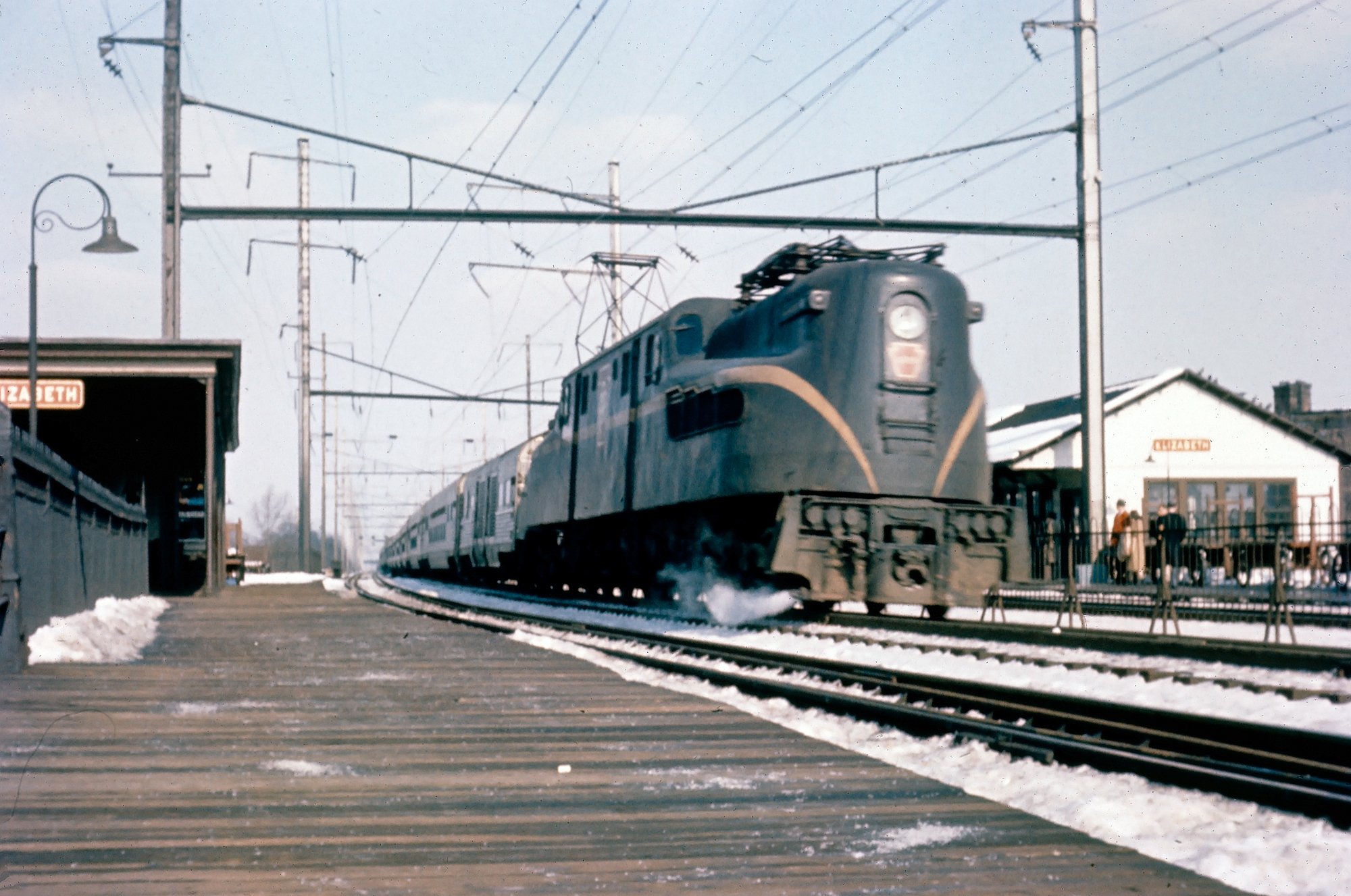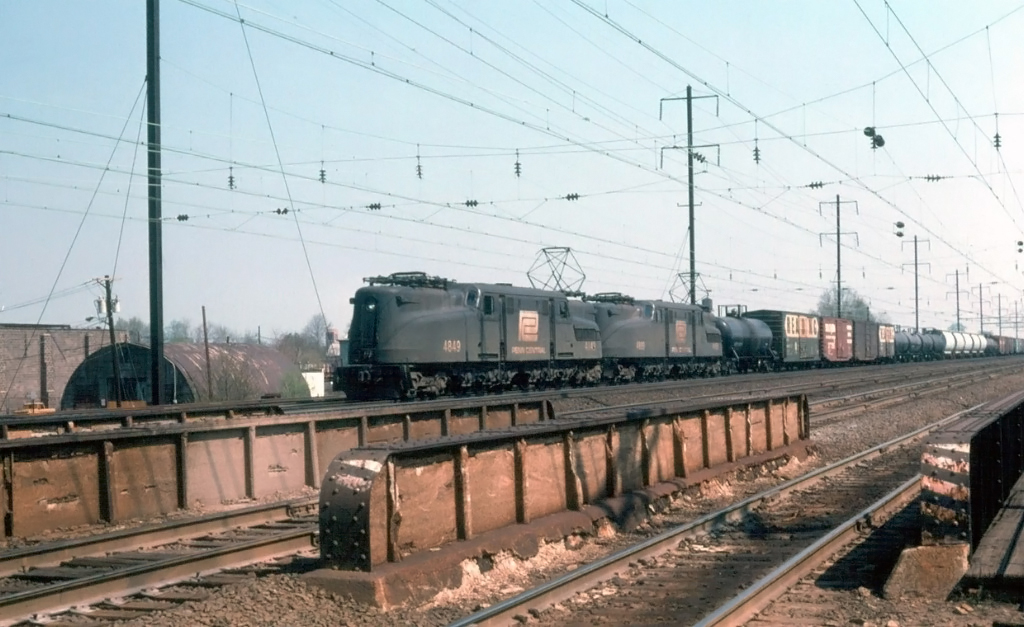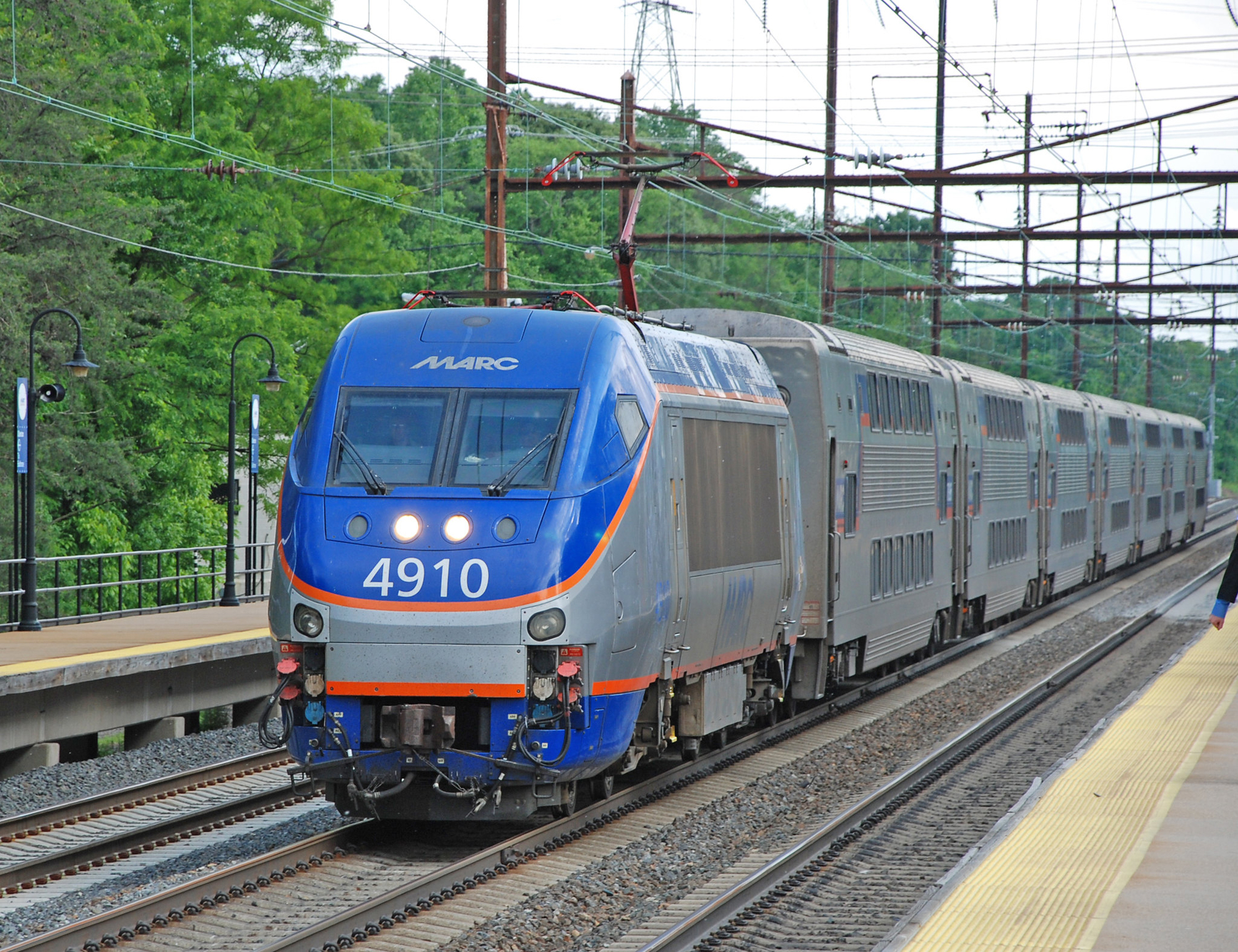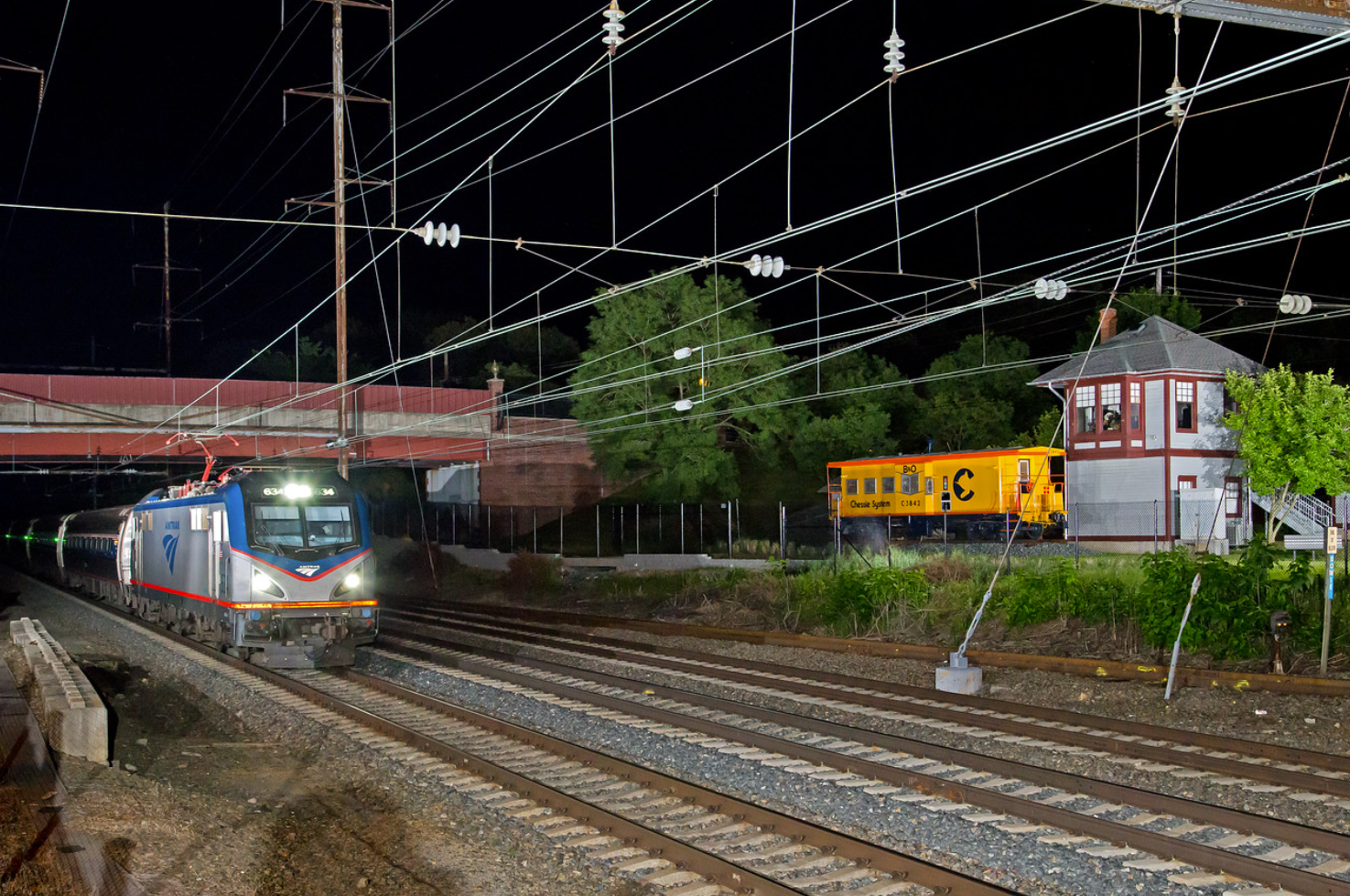Northeast Corridor: History, High-Speed Rail, Services
Last revised: February 26, 2025
By: Adam Burns
The Northeast Corridor (NEC) is the busiest passenger rail line in the United States, spanning approximately 457 miles from Boston, Massachusetts, to Washington, D.C. Operated by Amtrak, the NEC is a vital artery for commuters, long-distance travelers, and freight operators.
This essential infrastructure supports the economic vitality of the entire Northeastern United States, connecting the political, financial, and cultural capitals of the nation.
This article will delve into the rich history, various challenges, major upgrades, and current operations of Amtrak’s Northeast Corridor.
 The NEC's classic era. Pennsylvania GG-1 #4919 has the "Keystone" at Elizabeth, New Jersey, circa 1960. Meyer Pearlman photo. American-Rails.com collection.
The NEC's classic era. Pennsylvania GG-1 #4919 has the "Keystone" at Elizabeth, New Jersey, circa 1960. Meyer Pearlman photo. American-Rails.com collection.Historical Background
Early Beginnings
The origins of the Northeast Corridor can be traced back to the early 19th century when various independent railroads operated in the region.
The first passenger service commenced in 1834 with the Boston & Providence Railroad. By 1840, several other railroads, such as the New York & New Haven Railroad, and the Philadelphia, Wilmington & Baltimore Railroad, began operations, providing fragmented services across the Northeast.
As railroads expanded and merged, the idea of a cohesive Northeastern rail network began to take shape, leading to the creation of the Pennsylvania Railroad and the New York, New Haven, and Hartford Railroad, both of which laid down critical segments of today’s NEC.
Pennsylvania Railroad Era
The Pennsylvania Railroad (PRR) became a significant player in the NEC's development by constructing extensive rail lines between Boston and Washington. Its influence was particularly notable in the creation of infrastructure that remains integral to the NEC, such as the tunnels under the Hudson River, known today as the North River Tunnels, connecting New Jersey to Manhattan.
Electrification
In the late 19th century, a visionary named William J. Wilgus, the chief engineer of the New York Central Railroad (NYC), led a groundbreaking proposal to electrify the rail lines extending from Grand Central Terminal to Mott Haven. He utilized a cutting-edge third rail power system engineered by Frank J. Sprague. At the turn of the century, some branch lines of the New York, New Haven & Hartford Railroad (NYNH&H) employed electricity for interurban streetcars through either third rail or trolley wire systems.
A tragic incident underscored the necessity for change. On January 8, 1902, an accident in the Park Avenue Tunnel near the contemporary Grand Central Terminal claimed 17 lives due to steam locomotive smoke. This catastrophe triggered a public outcry, compelling a shift towards electric operations within Manhattan.
In 1905, the New Haven (NH) made a significant announcement: it would electrify its main line stretching from New York to Stamford, Connecticut. This electrification coincided with the monumental construction of Grand Central Terminal, completed in 1913. The NYC undertook its electrification efforts, marking a historic moment on September 30, 1906, with a successful test of suburban multiple-unit service to Highbridge station on the Hudson Line. Regular services commenced on December 11.
A landmark achievement occurred on February 15, 1907, when electric locomotives began operating at Grand Central. By July 1, 1907, NYC's passenger services into Grand Central were fully electrified. Subsequently, NH began electrification in Manhattan, reaching New Rochelle by July, Port Chester by August, and Stamford by October. The era of steam locomotives in Manhattan concluded on June 30, 1908, following a ban on steam trains. Consequently, all NH passenger trains entering Manhattan transitioned to electricity. NH’s electrification reached New Haven in June 1914, maintaining this status for over eight decades.
Parallel advancements were unfolding with the Pennsylvania Railroad (PRR) and its Pennsylvania Station equipped with electrified approaches. The Long Island Rail Road (LIRR), serving PRR's lines in New Jersey, ushered in electric service on the Atlantic Branch from downtown Brooklyn past Jamaica in 1905. Electric service extended to Long Island City by June 1910, forming part of the main line to Penn Station, which opened on September 8, 1910, for LIRR trains and November 27 for PRR trains. Both railroads operated on DC electricity drawn from a third rail. At Manhattan Transfer, PRR trains transitioned between electric and steam engines, and passengers could transfer to H&M trains bound for downtown Manhattan.
This epoch marked a transformative phase in urban transportation, setting the stage for the electrified infrastructure that powers New York’s bustling commute today.
On July 29, 1911, the New Haven Railroad initiated electric service on its Harlem River Branch, turning a suburban route into what would soon become a key main line upon completion of the New York Connecting Railroad and its iconic Hell Gate Bridge. The bridge itself debuted on March 9, 1917, initially serving steam locomotives which required an engine change at Sunnyside Yard, east of Penn Station, until electrification extended to the bridge in 1918.
Plans for electrification from New Haven northward to Providence and Boston were in the pipeline, authorized by the NH board of directors shortly before the United States' entry into World War I. Unfortunately, these ambitions were shelved due to the war and the financial difficulties that beset the company. It wasn't until the 1990s, under the aegis of Amtrak and utilizing a modern 60 Hz system, that the long-anticipated electrification north of New Haven was finally realized.
Post-War Decline
Following World War II, the NEC, like much of America's rail system, faced declining ridership due to the rise of automobile travel and the burgeoning airline industry. This period saw the financial collapse of several key railroads, including the PRR and the New York Central Railroad. The creation of the Penn Central Transportation Company in 1968, a merger between the PRR and the New York Central, was an attempt to stave off bankruptcy, but it ultimately failed, leading to Penn Central's bankruptcy in 1970.
In 1905, the Pennsylvania Railroad (PRR) embarked on a transformative journey to electrify its suburban lines in Philadelphia, setting the stage for a broader network using an 11 kV, 25 Hz AC catenary system that eventually spanned from New York to Washington. The first milestone was reached in September 1915, with electric multiple unit trains commencing service west to Paoli along the PRR Main Line, now the Keystone Corridor. Further strides were made with the commencement of electric service to Chestnut Hill (currently the Chestnut Hill West Line) and a segment of the Northeast Corridor (NEC) on March 30, 1918. By September 30, 1928, local electric service extended to Wilmington, Delaware, and further to Trenton, New Jersey, by June 29, 1930.
A significant expansion occurred on December 8, 1932, when electrified service between Exchange Place, the Jersey City terminal, and New Brunswick, New Jersey, started, incorporating the extension of Penn Station electric services from Manhattan Transfer. Electrification continued, and by January 16, 1933, the stretch from New Brunswick to Trenton was operational, creating a fully electrified line between New York and Wilmington. On February 12, 1933, trains to Washington began running under electric power to Wilmington, relocating the engine-change point from Manhattan Transfer to Wilmington. The same adjustment was made for westbound trains from Philadelphia to Paoli on April 9, 1933.
The Great Depression briefly stalled the electrification efforts south of Wilmington in 1933, but a pivotal loan from the Public Works Administration rejuvenated the project. This comprehensive upgrade included the reconstruction of Baltimore tunnels. The electrified service between New York and Washington officially commenced on February 10, 1935. By April 7, 1935, the electrification of passenger trains was complete, boasting 639 daily electrified services: 191 hauled by locomotives and 448 powered by multiple units. Additionally, New York–Washington electric freight service began on May 20, 1935, following the electrification of freight lines in New Jersey and Washington, D.C. The electrification extended further to Potomac Yard, across the Potomac River from Washington, along with several freight branches, achieved between 1937 and 1938. Potomac Yard remained electrified until 1981.
The Birth of Amtrak
In response to the failing passenger rail service, the U.S. government established the National Railroad Passenger Corporation, commonly known as Amtrak, in 1971. Designed to preserve intercity passenger service, Amtrak inherited the NEC from the Penn Central and other surviving railroads. This move marked the beginning of a concerted effort to revitalize and modernize the NEC.
Major Upgrades and Modernization
Early Investments
From the late 1970s through the 1980s, Amtrak and the federal government invested heavily in the NEC. Projects included track rehabilitation, the upgrading of signaling systems, and the introduction of new rolling stock. In 1986, the Northeast Direct service began, marking a steady improvement in reliability and speed.
The Electrification Project
A significant milestone came in the late 1990s and early 2000s with the completion of the electrification of the NEC north of New Haven to Boston. This $2.3 billion project modernized the infrastructure, allowing for seamless electric train operation from Washington, D.C., to Boston. The project also laid the groundwork for the introduction of high-speed rail on the NEC.
Introduction of the Acela Express
In 2000, Amtrak introduced the Acela Express, a high-speed service designed to compete with airline travel. Capable of reaching speeds up to 150 mph (241 km/h), the Acela significantly reduced travel times between major cities on the NEC. The Acela quickly became the flagship service of Amtrak, highly popular with business travelers for its speed and convenience.
 It's the very early Conrail era as a pair of former Penn Central GG-1's lead a general merchandise freight southbound on the Northeast Corridor at Stiles Street Yard in Linden, New Jersey during the spring of 1976. Randy Kotuby photo.
It's the very early Conrail era as a pair of former Penn Central GG-1's lead a general merchandise freight southbound on the Northeast Corridor at Stiles Street Yard in Linden, New Jersey during the spring of 1976. Randy Kotuby photo.Recent Developments and Future Investments
In the past decade, Amtrak has continued to focus on NEC improvements. In 2010, the American Recovery and Reinvestment Act provided substantial funding for infrastructure upgrades, including the replacement of outdated bridges and tunnels. In 2016, Amtrak announced the purchase of new high-speed trainsets from Alstom to replace the original Acela trains. These new trains, part of the Acela Express II program, promise even greater speeds and enhanced passenger comfort and are expected to enter service by 2023.
Current Operations
The NEC hosts a variety of Amtrak services tailored to different passenger needs:
1. Acela Express: The premier high-speed service traveling between Boston and Washington, D.C., with stops in major cities, including New York and Philadelphia. Business travelers especially favor the Acela for its speed, reliability, and amenities, such as first-class seating and onboard Wi-Fi.
2. Northeast Regional: This service offers a more economical alternative to the Acela Express, serving the same major cities and additional smaller stops. It caters to both daily commuters and long-distance travelers, providing a balance between cost and convenience.
3. Keystone Service: Operating between New York City and Harrisburg, Pennsylvania, the Keystone Service connects with the NEC at Philadelphia, offering another important route for regional travel.
Infrastructure and Technology
The current state of the NEC infrastructure includes several key components:
- Tracks: The NEC features over 450 miles of track, supporting high-speed, regional, and freight services.
- Signaling and Control Systems: A mix of modern and legacy systems governs train movements along the corridor. Advanced Positive Train Control (PTC) technology has been implemented to enhance safety.
- Stations: Notable stations include Union Station in Washington, D.C.; 30th Street Station in Philadelphia; Penn Station in New York City; and South Station in Boston. These hubs serve as major transfer points for both commuter and long-distance travel.
- Rolling Stock: In addition to the Acela Express trains, Amtrak operates a variety of locomotives and passenger cars on the route. The introduction of the next-generation Acela trainsets is expected to further modernize the fleet.
 Coming up the center track on Amtrak's Northeast Corridor is MARC northbound express train #538, led by HHP-8 #4910, at Odenton, Maryland on May 19, 2011. Doug Kroll photo.
Coming up the center track on Amtrak's Northeast Corridor is MARC northbound express train #538, led by HHP-8 #4910, at Odenton, Maryland on May 19, 2011. Doug Kroll photo.Commuter and Freight Services
The corridor is not solely an Amtrak domain; it is a shared resource with several commuter rail operators, such as:
- New Jersey Transit (NJ Transit): Serving the stretch between Trenton and New York City.
- SEPTA: Operating in the Philadelphia area.
- MARC Train: Providing service between Washington, D.C., and Maryland.
- MTA's Metro-North and Long Island Rail Road (LIRR): Serving the New York metropolitan area.
- MBTA: Serving the Boston area.
Freight services also utilize the NEC, with major operators like CSX and Norfolk Southern transporting goods along various sections of the corridor.
Challenges and Future Outlook
Despite its success, the NEC faces numerous challenges:
1. Aging Infrastructure: Much of the NEC’s infrastructure dates back to the early 20th century and Pennsylvania Railroad era, and is in dire need of modernization. Tunnels, bridges, and tracks require significant investment to maintain safety and efficiency.
2. Capacity Constraints: The corridor operates at or near capacity in many segments, particularly between New York and Washington, D.C. This congestion affects reliability and limits potential growth.
3. Funding: Finding sustainable, long-term funding for NEC maintenance and upgrades remains a complex issue, involving federal, state, and private stakeholders.
Upcoming Projects and Innovations
To address these challenges, several initiatives are underway or planned:
1. Gateway Program: This ambitious project aims to significantly increase capacity between New Jersey and New York City with new tunnels under the Hudson River and expanded rail infrastructure.
2. NextGen High-Speed Rail: The next-generation high-speed trains set to replace the original Acela fleet will bring faster travel times and improved passenger experiences.
3. State and Federal Investment: Recent infrastructure bills and state-level commitments promise to provide much-needed funding for NEC improvements.
4. Sustainability Efforts: Amtrak is investing in greener technologies, such as more efficient electric trains and eco-friendly station upgrades, aligning with broader environmental goals.
5. Customer Experience Enhancements: Upgrades to stations, onboard amenities like improved Wi-Fi, and customer service are part of Amtrak’s ongoing efforts to enhance the passenger experience.
 A modern day view of the Corridor as one of Amtrak's Northeast Regional trains passes the Bowie Railroad Museum in Bowie, Maryland. Loyd Lowry photo.
A modern day view of the Corridor as one of Amtrak's Northeast Regional trains passes the Bowie Railroad Museum in Bowie, Maryland. Loyd Lowry photo.Conclusion
The Northeast Corridor is more than just a rail line; it is a lifeline that supports the economic and social fabric of the entire Northeastern United States.
From its historic beginnings to its present-day operations, the NEC has continually evolved to meet the demands of modern travel. While challenges remain, ongoing investment and innovation promise to secure the NEC's future as a premier rail corridor.
Understanding the NEC’s rich history and current dynamics provides valuable insights into one of the world’s most essential rail networks.
Whether you're a daily commuter, a long-distance traveler, or a rail enthusiast, the Northeast Corridor remains an enduring symbol of the power and potential of rail transport.
Recent Articles
-
Oregon Railroad Museums: A Complete Guide
Apr 25, 25 03:11 PM
With its rich tapestry of scenic landscapes and profound historical significance, Oregon possesses several railroad museums that offer insights into the state’s transportation heritage. -
North Carolina Railroad Museums: A Complete Guide
Apr 25, 25 02:56 PM
Today, several museums in North Caorlina preserve its illustrious past, offering visitors a glimpse into the world of railroads with artifacts, model trains, and historic locomotives. -
New Jersey Railroad Museums: A Complete Guide
Apr 25, 25 11:48 AM
New Jersey offers a fascinating glimpse into its railroad legacy through its well-preserved museums found throughout the state.

